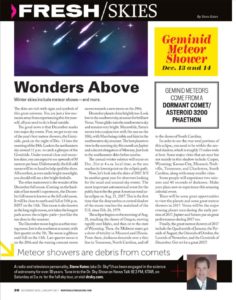Winter skies include meteor shows––and more
Winter skies include meteor shows––and more.
By Steve Kates
The skies are rich with signs and symbols of this great universe. You are just a few moments away from experiencing this for yourself, all you need to do is head outside.
The good news is that December marks two major sky events. First, we get to see one of the year’s best meteor showers, the Geminids, peak on the night of Dec. 13 into the morning of the 14th. Look to the northeastern sky around 11 p.m. to catch a glimpse of the Geminids. Under normal clear and moonless skies, one can expect to see upwards of 50 meteors per hour. Unfortunately, the full cold moon will be on hand to help spoil the show. All is not lost, as even under bright moonlight, you should still see a few bright fireballs.
The other main event is the wonder of the December full moon. Coming on the backside of last month’s supermoon, the December full moon is known as the full cold moon. It will be close to earth and full at 5:06 p.m. MST on the 13th. This moon is also known as the long night moon, as it takes the longest path across the ecliptic path––just like the sun does in the summer.
The December moon begins as a thin waxing moon, low in the southwest at sunset, with first quarter on the 7th. The moon is gibbous until full on the 13th. Last quarter moon is on the 20th and the waning crescent moon moves towards a new moon on the 29th.
December planets shine brightly too. Look low in the southwest sky at sunset for brilliant Venus. Venus glides into the southwestern sky and remains very bright. Meanwhile, Saturn moves into conjunction with the sun on the 10th, with Mars being visible and faint in the southwestern sky at sunset. The best planets to view in the morning sky this month are Jupiter and a decent elongation of Mercury. Just look to the southeastern skies before sunrise.
The annual winter solstice will occur on Dec. 21st at 4 a.m. local time, as the sun reaches its lowest point on the ecliptic path.
Now, let’s look into the skies of 2017. It’ll be another great year for observers looking for the usual and unusual sky events. The most important astronomical event for the public has to be the great American total solar eclipse on Aug. 21, 2017. This is the first time that the deep umbra or central shadow of the moon touches the mainland of the U.S. since Feb. 26, 1979.
The eclipse begins on the morning of Aug. 21, touching the shores of Oregon, moving rapidly over Idaho, and then on to the state of Wyoming. Then, the Midwest states get a show of totality in Missouri and Illinois. From there, darkness descends over a thin line in Tennessee, North Carolina, and off to the shores of South Carolina.
In order to see the true total portions of this eclipse, you need to be within the umbral shadow, which is roughly 73 miles wide at best. Some major cities that are near but not mainly in this shadow include: Casper, Wyoming; Kansas City, Missouri; Nashville, Tennessee; and Charleston, South Carolina, along with many smaller cities.
Some people will experience two minutes and 40 seconds of darkness. Make your plans now to experience this amazing celestial event.
There will be some great opportunities to view the planets and some great meteor showers in 2017. Venus will be the major evening planet seen during the early portion of 2017. Jupiter and Saturn put on great performances during 2017 too.
Finally, the great meteor showers of 2017 include the Quadrantids of January, the Perseids of August, the Orionids of October, the Leonids of November, and the Geminids of December. Get set for a great 2017!
Geminid Meteor Shower––Dec. 13 and 14
- Meteor showers are debris from comets
- Geminid meteors come from a dormant comet/asteroid 3200 Phaethon
- Many Geminid meteors are seen as bright fireballs
Related posts
Leave a Comment
You must be logged in to post a comment.







